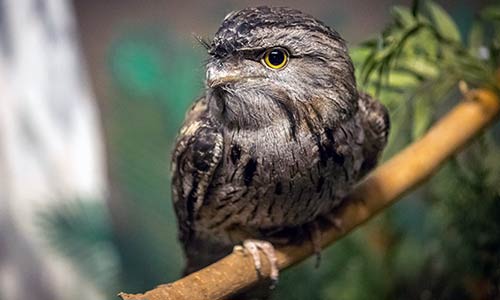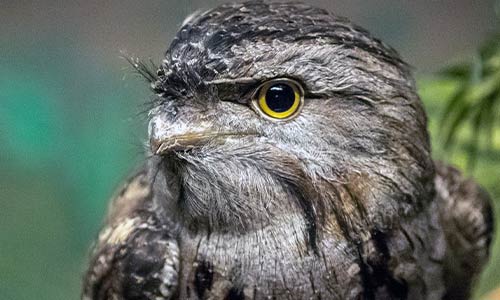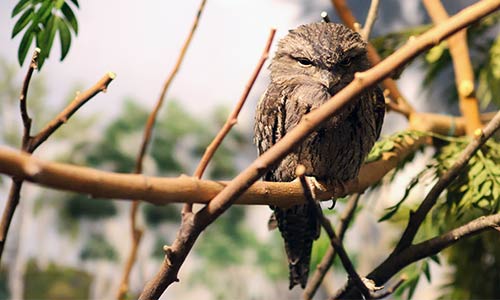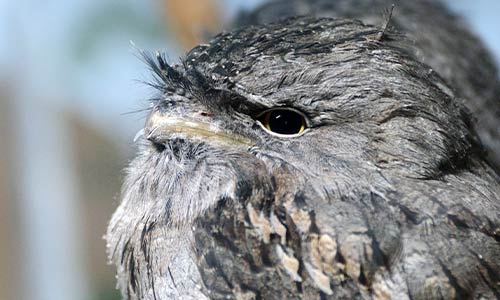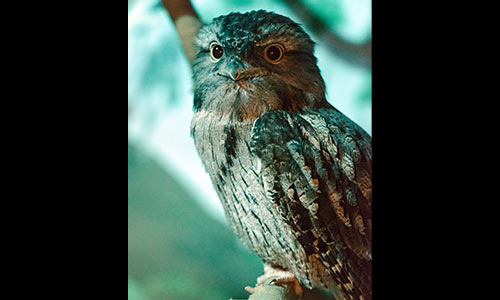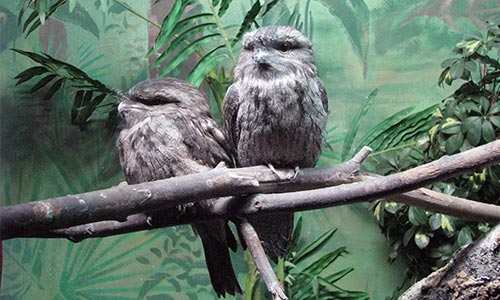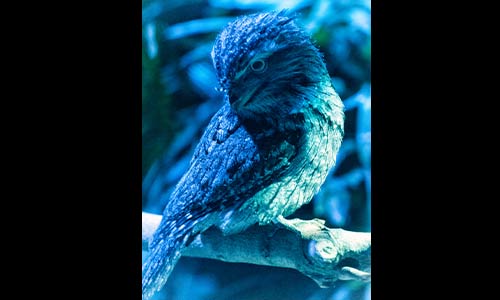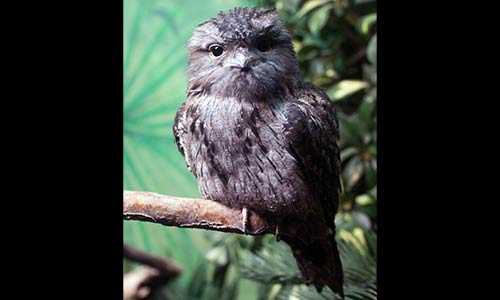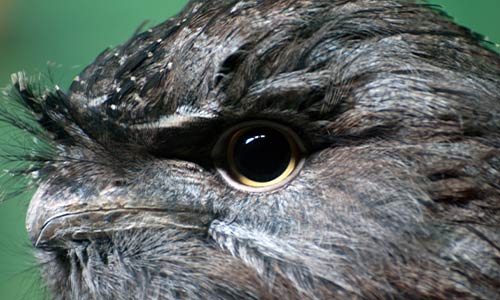Tawny Frogmouth
Podargus strigoides
About the Tawny Frogmouth
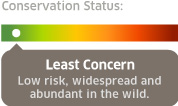
Geographic Range:
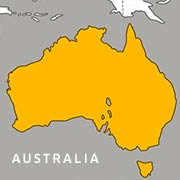
Class: Aves
Order: Caprimulgiformes
Family: Podargidae
Genus: Podargus
Species: strigoides
Tawny frogmouths are native to Australia and Tasmania, where they live in forest and scrubland trees. Their gray or muddy brown colored feathers provide excellent camouflage in their habitat. Tawny frogmouths are family-oriented birds. They are monogamous and share equally in duties such as sitting on eggs and feeding their chicks.
Frogmouth Facts
Appearance:
Though often mistaken for an owl, the tawny frogmouth is actually a member of the nightjar family, which includes insect-eating, nocturnal birds like nightjars and nighthawks. Its name comes from its unusually wide, frog-like beak, which is triangular, sharply hooked, and fringed with whisker-like bristles.
These medium-sized birds are crepuscular or nocturnal, with long wings, short legs, and stout bodies. Their legs and feet are relatively weak, so rather than grasping prey, they rely on ambush: sitting silently until an insect or small animal comes within range, then pouncing and capturing it with their wide, hooked beak. Their primary feathers are frayed, allowing for near-silent flight similar to owls.
Most frogmouths have large, bright yellow eyes, brownish-gray plumage with mottled black streaks and spots for perfect camouflage against tree bark, wispy head feathers, and thin bristles around the beak. Their rounded, medium-length wings help them descend quickly and quietly to snatch prey, while their short legs and weak feet distinguish them from true owls.
Adult:
- Length: 34–53 centimeters
- Wingspan: 65–98 centimeters
- Weight: 200–650 grams
- Beak length: Males: 60–65 millimeters; Females: 58–62 millimeters
Hatchling chick:
Weight: Approximately 19 grams at hatch, gaining an average of 8.3 grams per day until fledging
Fledgling chick:
Weight: Approximately 250 grams
Diet:
Carnivorous, feeding on millipedes, centipedes, scorpions, ants, wasps, and other nocturnal insects, as well as worms, slugs, snails, small mammals, frogs, birds, and lizards. Like birds of prey, tawny frogmouths regurgitate indigestible parts of their food—such as hair and exoskeletons—in the form of a cast.
Reproduction:
Tawny frogmouths can form lifelong partnerships, staying together in the same territory for up to ten years. They reach sexual maturity between 9 and 12 months of age, and their breeding season typically runs from August to December. In arid regions, some pairs may begin breeding after periods of heavy rain.
While they don’t have a formal courtship display, mutual grooming is important—males gently preen females for sessions that can last up to ten minutes. Breeding pairs frequently roost side by side on the same branch, their bodies touching.
Females usually lay two eggs, sometimes three, spaced a day or two apart. Incubation begins with the first egg. The male typically sits on the eggs during the day while the female perches nearby, and both share incubation duties at night. During this time, the male enters a “brooding trance,” remaining still on the nest but not using his camouflage posture. The female, by contrast, reacts quickly to any disturbance, fluffing her feathers to appear larger and ward off potential predators.
Both parents take turns feeding each other while one remains on the nest. The eggs are turned roughly every 12 hours and hatch after about 30 days. Tawny frogmouths build loose nests made of sticks, often balanced on a horizontal fork in a tree, and both sexes gather the nesting material. Chicks usually fledge 25 to 35 days after hatching. Most pairs raise one clutch per season, though some in southern regions may have two.
Behavior:
Wild tawny frogmouths don’t form large social groups. It’s uncommon to see more than two together. Unpaired birds are mostly solitary, while mated pairs typically stay close or at least within the same territory. Fledglings remain near and dependent on their parents for 1–2 weeks after leaving the nest, and chicks may stay with their parents for several months before dispersing, though the full extent of this dispersal is unknown.
When threatened, tawny frogmouths rely on their camouflage. Their mottled plumage helps them blend into tree bark, and they often stay perfectly still with eyes closed and beak pointed skyward. If a predator gets too close, they may flee—or try to intimidate by opening their wide, bright yellow mouth.
Habitat/range:
Found throughout Australia except in far western Queensland, central Northern Territory, and Tasmania. Tawny frogmouths are uncommon in rainforests and treeless deserts but can inhabit urban and suburban areas, showing a strong ability to adapt to human presence.
Conservation:
In the wild, tawny frogmouths face several threats, including pesticide poisoning, attacks by pets or feral dogs and cats, and collisions with vehicles while chasing insect prey.
Median Life Expectancy:
In the wild, banded tawny frogmouths have been documented living up to 14 years.
You Can Find This Animal in the Outback Trail
Owl Lookalike
Though often mistaken for an owl, the tawny frogmouth is actually a member of the nightjar family, which includes insect-eating, nocturnal birds like nightjars and nighthawks.
You might also like
At Franklin Park Zoo:
At Stone Zoo:

